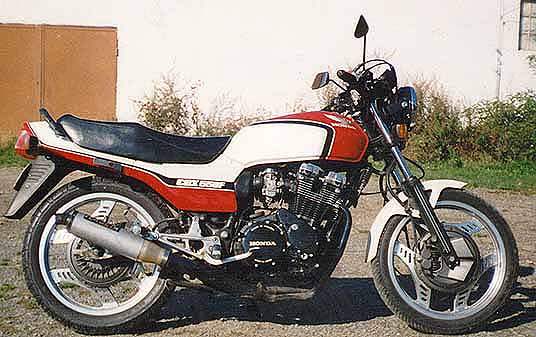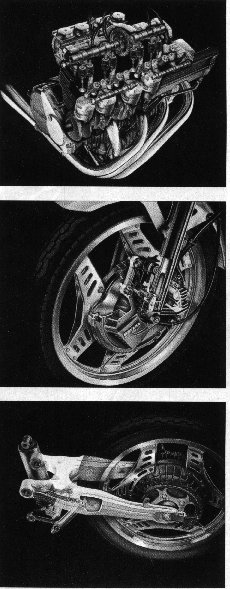
Ivo Oprsal's CBX550F (Non-standard exhaust system fitted)
What Was the CBX Anyway?
History
In the early part of the 1980's, Honda, encouraged by raging sales successes and on-track performances, introduced a plethora of models, many of which were, for better or worse, destined to only last for very short periods of time. Bikes like the two stroke MVX250 with its GP-aping motor, came and went, disappearing almost without a trace. Apart from the spare parts implications that this had for prospective buyers, it also meant that many models were not fully developed to work out design and production bugs and many did not get a real opportunity to establish a market niche.
Such a bike was the Honda CBX550 which sold in Australia, unchanged except for differing graphics, for just 2 years, from 1982 to 1984. Introduced as, and rightfully claimed, as the spiritual successor to the late, lamented Honda 400/4 (Motorcycle Trader, June 1998) it arrived to rave reviews from the press. It was favourably compared with the "gun" bike of the 550 category at that time, the Kawasaki GPz550 and won several comparison tests at the time,
The Honda bristled with innovations, some of them of great value and some seemingly included as part of the design for no other reason except to show that it could be done. From the front, it sported linked, air assisted front forks, TRAC (Torsion Reactive Anti-Dive Control), one of the first middle weight bikes to have anti-dive, enclosed double disk brakes that featured cast iron disks attached at the periphery and gripped by calipers that worked from "inside" the disk.

An excellent shot that shows (Top to Bottom) a cutaway of the 4 valve per cylinder 572cc emgine, the front disk brake assembly as explained above and the rear ProLink suspension.
The instrument panel was one of the many features where there was a conscious attempt to maintain or promote a family connection to Honda's "big gun" the CBX1000 six cylinder. The rear suspension featured Honda's own mono shock design, called "Pro Link" and the rear shock was also air assisted. A single, shrouded disk brake like the front pair, took care of braking at the rear. Honda's patented "Comstar" wheels were fitted
It came in two models, an unfaired model simply called the "F" and one with a frame mounted 1/4 fairing designed to maintain marque identity with the CB900F2 of the time, called the FII. Only two colour schemes were available, a red/orange/black scheme and a red/white/blue, (very HRC in design). Strangely, the non-HRC colours were vastly more popular and will be the scheme most likely to be found in 2nd hand buying. The final 1984 model had a plain orange colour all over with just Honda decals to lift it and was not popular. The bikes were beautifully finished and detailed, as Honda always were, and they still look very attractive (to me at least), having the fashionable, "leaning forward" look without taking it to extremes.
The bike was powered by a 572 cc engine that had a claimed horsepower of 65 bhp at 10000 rpm. It was DOHC, of course, and had 16 valves. Claimed dry weight was 184 kgs and tested performance figures were 12.72 sec standing 400m and a top speed of 186 kph.
On the Road
Like most middleweights of the time, the CBX was quick, nimble by virtue of its short wheelbase and thrived on revs. Which is not to say that it was a "peaky" engine, because solid torque was available from around 3000 rpm onwards, right through to redline with no trace at all of a "power band". This was especially true of the bike with standard exhaust, that delightful "bunch of bananas" crossover network that unfortunately usually only lasted for 20000 ks or so before turning to ferrous oxide from the inside out. Once fitted with an aftermarket 4-into-1, the torque spread began at over 4000 rpm instead and again was seamless to redline.
The bike is a great sports bike, being quick to turn in, having excellent brakes and having good drive out of the corners, see above. However, it is also an excellent tourer, its six speed gearbox providing a good spread of ratios and often leading to the "I'd better shift up to top cos the bike's still pulling hard" syndrome, only to find that it already IS in top and is still feeling strong. The seat is comfortable and well proportioned and can carry a pillion with ease, a good pillion grab handle being provided. However, a CBX purchased now would certainly benefit from a seat rebuild, with high density foam as time tends to be unkind to most Japanese bike seats.
The engine is unbelievably smooth for a four and has no pronounced "tingle" at any revs. Overtaking can often be accomplished in 6th, but the slick, almost error-proof gearchange can always find you the right ratio anyway. Fuel consumption varies with the frequency with which the right wrist is exercised, but expect around 230 kms before needing to switch to reserve. I have squeezed 300 ks out of a tank on a number of occasions while touring, which represents around 53 mpg (sorry I can't tell you what that is in new measurement....if you're going to go metric, makes sure you go every inch of the way)
I have personally used my 3 CBX's (2 FII's and one F) for all manner of riding and found them to be entirely competent at all exercises. I have owned them from 1983 to the present and am an avowed CBX550 fan (obviously)
The bike does have one disturbing tendency which has no real valid cure (that I have found anyway). Due to the short rake/trail, which is a blessing when you're "scratching", it can be a little nervous around the front end. The presence of the complex brake arrangement at the bottom of the forks probably contributes to this also, adding to the unsprung weight. This is especially noticeable when you're slowing down to a traffic light and you take your hand off one of the bars to flip up your visor. The front end can shake quite noticeably under these conditions, which can be a bit alarming. Many riders "solved' this problem by fitting a larger section front tyre, but while this masked the problem, it brought a penalty in slowing down the steering and made the bike less nimble.
However, in the heat of battle, the bike is very stable and bumps mid-corner do not upset it at all.
A steering damper would be the obvious solution, but I was never able to find a way of fitting one to the FII model due to the fairing. Fitting tapered roller steering head bearings and cinching them down a *little* tighter than recommended can also assist. The better bearings should be fitted anyway.
Apart from that, there are no hidden vices and the bike is a delight on the road. I have ridden in all conditions and have found the brakes strong despite repeated applications, and yes, they DO work in the wet! and the handling faithful and predictable.
Which Model?
Well, not much problem here. The FII model was much more popular and is likely to be the one most found in used ads. The fairing is more than cosmetic and does provide some useful shelter, albeit not for the hands. The later, solid colour models are less plentiful, but may be slightly lower mileage. With such a short model run, you're unlikely to find a still low mileage one, so be careful. I was lucky, sourcing mine private sale in July 1991 with just a genuine 8500kms on the clock, one owner.
Useful Contacts.
Me, for a start. Having owned 3 of them, I have encountered most of what you will. Workshop manuals are available; try the 2nd hand stores and see if you can get a genuine one, they are excellent. Spares are still available, but not as easy to find, obviously. My Japanese friend, Yutaka Yasuda has the Original and excellent CBX400/550 web site.
Conclusion.
The CBX550 is an excellent choice for a rider with a limited budget who wants to sample what good, high performance middleweight riding is all about. The bike is sophisticated and fast and responds well to most sorts of riding environments. It's fast enough to be exciting, flexible enough to be a good tourer and has the added benefit of being different. In the day when most sports bikes resemble a flying condom, the CBX stands out and makes a statement that is as valid today as it was in 1982. Long live the CBX550!
Phillip Hall
Canberra June 1998
Return to Main Page.
Copyright © 1998 HallTech Consultancy.
Photos © HallTech Consultancy.


